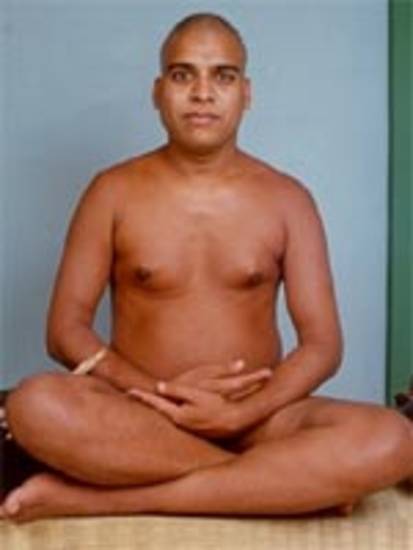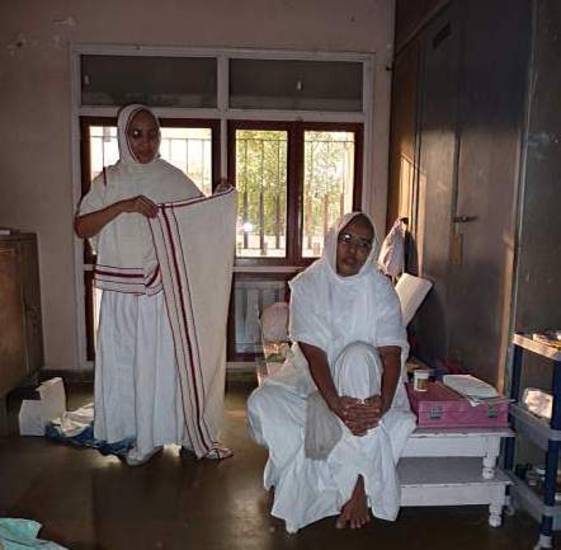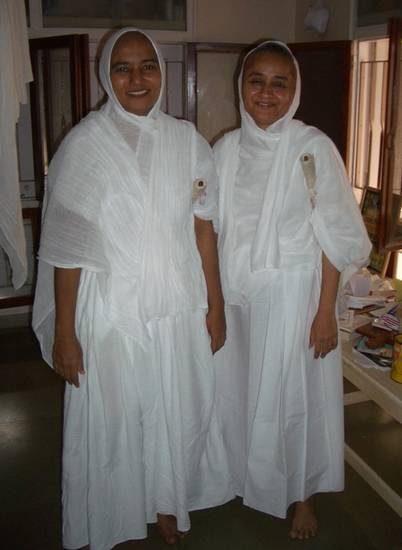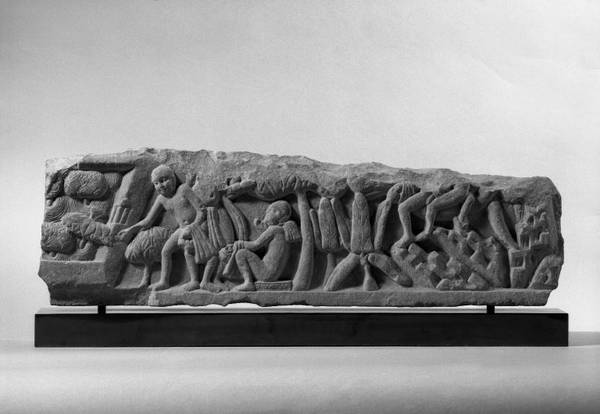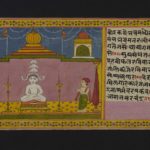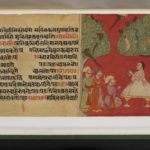Article: Monastic clothing
Even though the two major Jain sects take their names from their respective mendicant clothing practices, lay people of all Jain sects wear clothes. The issue of nudity or clothing is discussed only for mendicants. Monastic clothing has become the most obvious way to differentiate male mendicants of the Śvetāmbara and Digambara sects, which form the two main Jain sectarian traditions. The former means ‘white-clad’ in Sanskrit while the latter means ‘sky-clad’ – that is, naked. It is not as superficial a topic as it may appear, because wearing or not wearing clothes symbolises attachment or non-attachment to the world respectively.
Both male and female mendicants take a vow of non-possession when they become monks and nuns. As the ideal to which mendicants aspire, the ‘perfect ascetic’ demonstrates total detachment from the things of the world. This includes not just objects but emotions of all kinds, since complete detachment enables spiritual progression towards omniscience and liberation from the cycle of births. Disagreements over the interpretation of the vow of non-possession – aparigraha – support the different practices of the sects when it comes to whether their mendicants wear clothing and, if so, what kinds of clothing are permitted.
The sectarian attitudes towards mendicant clothing can be seen most clearly in the issue of female nudity. Female mendicants of all sects wear white robes. However, Digambara nuns are not considered to be the female equivalent of monks because they are not permitted to be nude. Since, for Digambaras, mendicants must renounce clothing to achieve salvation, nuns are not considered capable of the level of spirituality required for liberation. In contrast, Śvetāmbaras believe that nuns are just as capable of gaining emancipation as monks, even though both wear clothes. For them, detachment involves having no feelings of attachment to monastic equipment, not in using the items themselves. Both sects consider certain items vital to living a religious life.
Examples of both clothed and nude figures can be found in Jain art. Early depictions of Jinas show them naked but loincloths appear around the fifth century. Since then idols created by the Digambara and Śvetāmbara sects have usually demonstrated representative attitudes towards mendicant nudity. This results in Śvetāmbara images wearing loincloths while Digambara images are naked.
To non-Jains, being nude in public for any reason can be disturbing, shocking or even wrong from a religious point of view. This has led to periods when rulers of India discouraged or banned public nudity. The official disapproval of nudity in the 19th century weakened as Digambara monks revived the custom in the early 20th century. Though there is a national law against nudity in public, the principle of religious nudity is legally accepted. However, attitudes towards public nudity today vary and Digambara monks may try to adapt to the traditions of the local population.
Nudity and clothing
The Sanskrit terms for nudity are nagnatva or a-celakatva, the latter meaning literally ‘absence of clothing’. Partly in recognition that living naked is difficult, not all Digambara mendicants go nude. Full monks – munis – among the Digambaras go without clothing, while novices and juniors wear garments. Digambara nuns wear white robes, as do monks and nuns of the Śvetāmbara sect.
For the Digambaras, nudity is a symbol of perfect detachment from everything, whether material possession or moral defilement. Therefore it is necessary stage in the theoretical possibility of reaching salvation. This is stated very clearly by Kundakunda, one of the most famous authoritative Digambara voices, who lived around the first century of the Common Era:
According to the Teaching of the Jina, a person wearing clothes cannot attain mokṣa [emancipation] even if he be a Tīrthaṃkara. The path of mokṣa consists of nudity (nagna); all other paths are wrong paths
Suttapāhuḍa, verse 23
translated by Padmanabh S. Jaini, page 35, 1991
In the Śvetāmbara tradition, absolute nakedness is the rule only for spiritually advanced monks who live according to the rule of Jinas – jinakalpikas – or for Jinas themselves. For example, according to the Kalpa-sūtra, when Mahāvīra, the 24th Jina, renounced worldly life in order to become an ascetic, ‘for a year and a month, he wore clothes – cīvara-dhārī; after that time he walked about naked – a-cele, and accepted the alms in the hollow of his hands’ (Jacobi 1884: 260). The first Jina, Ṛṣabhanātha or Lord Ṛṣabha, also lived most of his monastic life without clothing. The other 22 Jinas, however, wore clothes after renunciation.
The fact that nakedness is one of the 22 disturbances – parīṣahas – which a mendicant has to try to face with equanimity refers to a situation where it was the rule to be followed:
‘My clothes being torn, I shall [soon] go naked’, or ‘I shall get a new suit’, such thoughts should not be entertained by a monk. At one time he will have no clothes, at another time he will have some; knowing this to be a salutary rule, a wise [monk] should not complain about it
Uttarādhyayana-sūtra, 2: 12–13
translation by Hermann Jacobi, page 11, 1895
Another argument in favour of nudity is that clothes may attract minute living beings through dirtiness. Since these beings could be destroyed, even involuntarily, clothes hinder the practice of perfect non-violence, one of the key principles of Jainism.
For average ascetics, however, the use of clothing is the rule.
Passages found in the scriptures, Digambara as well as Śvetāmbara, show that clothing:
- protectis the body from heat, cold and insect bites
- contributes to the sense of shame
- avoids the disgust that the sight of a naked body may produce.
Such statements underline the fact that going nude is not something easy and that not all ascetics can do it. Being able to go naked without feeling embarrassed requires detachment with regard to both the body and onlookers’ eyes. Hence nudity means being invulnerable to the ‘passions’ or emotions, to which shame and pride belong (Dundas 2002: 50). For instance, a Digambara commentator recommends that male ascetics can use clothes if they have genital or other deformities (quoted in Jaini 1991: 100). This, however, seems quite unusual, as the rule is normally that people with deformities are not allowed to receive monastic initiation.
In general, nudity produces great respect among the Jains because only those who are capable of full detachment can practise it in total freedom and have inner purity.
Concept of possession – parigraha
Non-possession or non-attachment is the theoretical ideal of Jain mendicants. The question is then whether wearing clothes contradicts this ideal or not. In fact neither Śvetāmbaras nor Digambaras regard clothing as a possession – parigraha. Both sects view certain items as essential to a proper mendicant lifestyle, but their interpretations of whether clothing is one of them vary.
The view of the Digambaras is rather radical in that they take this literally. From their perspective, rejection of clothes to live in total nudity is the clearest example of non-possession. Therefore only the most advanced ascetics can achieve this.
Śvetāmbaras promote a different interpretation of possession and non-possession. For them parigraha is attachment or feeling of ownership. Thus it is not related to clothing or to the number of monastic equipment ascetics use. This equipment, such as brooms and staffs, is viewed as necessary to live a religious life and such items are not embellishments.
Monastic robes are normally not private or individual properties. They are part of the equipment the newly initiated mendicant gets at the time of initiation – dīkṣā. During this ceremony clothes play a symbolic role. Before initiation the candidate is dressed richly, like a prince or a princess. After initiation he or she wears only the sober white monastic robes. These robes are also part of the religious gifts – dāna – lay people can offer.
Receiving and using clothes
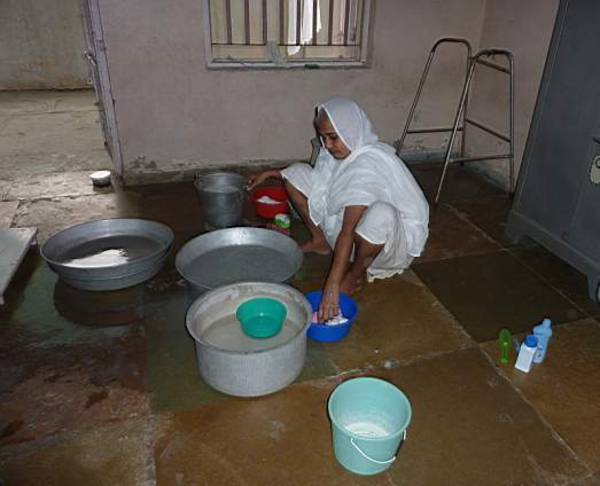
Nun washing clothes
Image by Nalini Balbir © Nalini Balbir
Ascetics receive monastic clothes from lay people in the same way they accept food or other monastic equipment from them as alms. One chapter of the Ācārānga-sūtra, the first of the Śvetāmbara scriptures, is devoted to this topic and provides rules that have to be followed. They relate to:
- authorised materials
- size and number of clothes
- distance the mendicant may cover in order to get them, and other such details
- provenance.
Only natural fabrics made from plants are permitted, such as wool and cotton. Animal products, such as furs, or any material using animal hair is forbidden. Expensive, perfumed or embroidered clothes are also not allowed. When monks and nuns receive clothing, they should not do anything to it, such as washing or dying.
Mendicants should not request clothes belonging to the donor, as it would amount to theft.
These rules are meant to eliminate reasons for quarrelling, mutual envy, attachment, breaking of self-control and so on.
Similarly, washing clothes is not supposed to be done haphazardly (see Deo 1960, pages 260 to 261 for ancient prescriptions). Mendicants must use boiled water, to ensure no living beings are in the water, and, theoretically, no detergent. This reduces the level of unavoidable violence involved.
Moreover, scriptures dealing specifically with rules of monastic life show how clothes were worn depending on circumstances. Generally, the complete outfit is worn when the ascetics go out for their alms-round, for preaching, for pilgrimage and so on. They are allowed to wear lighter clothing when inside the monastic lodgings.
Nudity, clothing and female ascetics
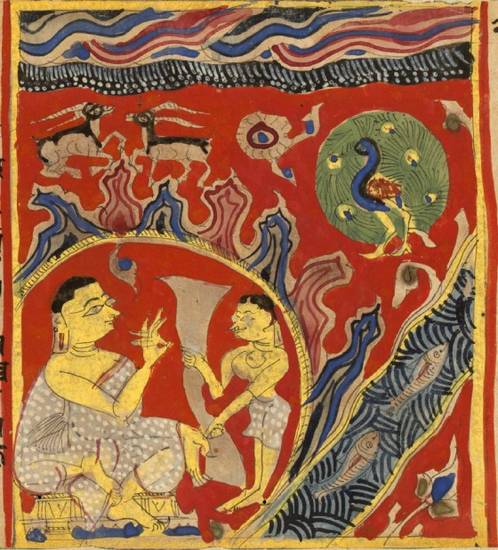
Rājīmatī and Rathanemi in the cave
Image by Victoria and Albert Museum © V&A Images/Victoria and Albert Museum, London
According to a saying of Jain scriptures frequently quoted in debates about nuns’ clothing, ‘it is not permitted that a nun may go without clothes’ (Bṛhatkalpa, in Jaini 1991: 56). This is mirrored in practice both past and present. Underlying this are the notions that inherently female qualities are denied if women go without clothes and that female nudity weakens self-discipline among males. The issue of female nudity is also strongly connected to the question of whether women can achieve a high enough spiritual level to reach liberation.
In Indian culture nudity signals rejection of bashfulness and shame, which means a nude woman must deny the qualities which society recognises as recommended to females. Female nudity also leads to increased excitement and lack of control in men, especially male ascetics, whose self-control could be endangered.
A well-known instance involves Rājīmatī and the monk Rathanemi, brother of her former fiancé Prince Nemi. After she had become a nun, Rājīmatī was caught in a heavy storm on her way to Mount Girnar. Seeking shelter in a cave, she took off her wet clothes and when she ‘was naked as [the day] she was born, thus she was seen by Rathanemi, whose [peace of mind] became [thereby] disturbed’ (Uttarādhyayana-sūtra, 22: 33–34; Jacobi 1895: 116–117).
These reasons mean a female ascetic cannot renounce clothes. The following statement is a good representative of the dilemma:
The teacher allows clothes for nuns, even though they are a possession, because in abandoning clothes there would be a total abandonment [of all the mendicant restraints], whereas in wearing clothes there is only a minor defect
Strīnirvāṇaprakaraṇa, verse 33
translated by Padmanabh S. Jaini, page 57, 1991
This leads to the conviction among Digambaras that a woman cannot reach emancipation. She must be reborn as a man to be liberated.
In contrast, Śvetāmbaras believe that clothes are not a possession but an aid to emancipation, like other items of monastic equipment. Therefore they believe that women are able to reach salvation.
The best example of the extensive debate between the two camps is the Strīnirvāṇaprakaraṇa (see Jaini 1991: 41–108). The text’s author is not a Śvetāmbara but a Yāpanīya, a short-lived mendicant order that tried to compromise between radical positions. The position of opponents to female emancipation is best summarised thus:
Nudity must be considered a prerequisite for mokṣa; if this were not so, it would not be obligatory for males also. Being unfit for nudity, a woman must be considered unfit for Siddhahood [= liberation of the soul], like anyone who is unfit to receive initiation
Strīnirvāṇaprakaraṇa, verse 56
translated by Padmanabh S. Jaini, page 57, 1991
Clothing
Monks and nuns always wear white clothing, though some garments may be a pale cream colour. Some subsects may have identifying bands of colour on their robes.
The regulations on monastic clothing go into detail about the number, type and fabric of garments which Jain mendicants are permitted. Directions on where and how to wear them are also included in the scriptures.
Clothing depends to some degree on rank and status. Since nudity is associated with a high state of spirituality, lower-ranking monks among the Digambaras wear more clothes. Śvetāmbara monks wear three garments. Digambara nuns wear two items of clothing at most while their Śvetāmbara counterparts use up to four.
Colour
Pure white is the only colour of Jain monastic clothing, whatever the order to which mendicants belong.
Jains who wear orange or yellow robes are either temple attendants – pujāris – or Digambara clerics known as bhaṭṭārakas. On holy days lay people may also wear orange, which is a sacred colour in India.
Digambara ascetics
Although the Digambara sect is known for the nudity of its monks, not all mendicants in the sect live naked. Men who are initiated into the Digambara mendicancy pass through novitiate stages. They may not become fully-fledged monks, who are the ones who go nude.
Digambara nuns are not technically mendicants, since they cannot renounce clothing and thus cannot fully renounce the world. As spiritually advanced lay women, they wear white robes. However, they follow the same rules of mendicant lifestyle as the male ascetics.
Male mendicants

Digambara monks and novices
Image by Takeo Kimiya © Takeo Kimiya
The three stages of male monastic hierarchy among Digambaras are reflected in whether clothes are worn or not. The stages depend on the man’s level of spiritual advancement.
Digambaras connect these stages with the general scheme of the pratimās, recognised by both Digambaras and Śvetāmbaras. This scheme defines a progression of 11 degrees, by which a lay man slowly renounces household life (Jaini 1991: 38–39; Wiley 2004: 245). As the table makes clear, nudity thus represents the culmination of a graduated path.
|
Mendicant stage |
Clothing |
Pratimā scale |
|---|---|---|
|
novice – kṣullaka |
Three pieces of clothing:
But Carrithers (1989: 222) states that ‘he wears only two garments: a loincloth and an upper cloth. He may not use a blanket’. |
10th – stage of leaving the household, or becoming a monk |
|
junior – ailaka |
One garment:
|
|
|
monk – muni |
nudity |
Post-pratimā stage – has climbed the full scale |
Female mendicants
A Digambara female ascetic can never go naked. Her clothing depends on her position in the ascetic community, which itself depends on the degree of her spiritual advancement.
A female novice – kṣullikā – keeps two pieces of clothing. She wears a white sari and covers the top part of her body with a long shawl. She removes this shawl while eating.
A Digambara nun –āryikā – wears only one piece of clothing, a white sari.
Śvetāmbara ascetics

Śvetāmbara monks and equipment
Image by Nalini Balbir © Nalini Balbir
Śvetāmbara ascetics of both sexes wear clothing, which is closely defined by scriptural rules. Monks’ clothes are much simpler than nuns’ robes. Nuns’ garments are loose-fitting and almost entirely cover them.
Since time immemorial all Jain mendicants have walked barefoot. In recent years, however, a minority of Śvetāmbara mendicants has started using cotton sandals or socks. Usually, only aged or suffering monks or nuns wear them but younger mendicants sometimes use them too, especially in winter in northern India, when it gets very cold.
Male mendicants
Śvetāmbara monks are allowed the following three garments:
- two of cotton, worn underneath
- one of wool, worn on the top (Deo 260: 258).
But there are different rules according to the status of the mendicant, the age of texts (see Deo 1960) and the practice of various monastic orders. The passage from the Ācārānga-sūtra mentioned above refers to a context which could be that of the fifth century BCE. Today’s monastic clothes are not identical to the prescriptions in such a text. Stitched or unstitched, the robes are folded and wrapped around the body. The mendicants wear the complete outfit whenever they go out of their lodgings. When inside their lodgings, they may take off the outer garment.
Female mendicants
Śvetāmbara scriptures have a variety of technical terms for nuns’ garments, which are much more complicated than monks’ clothes. Nuns have to be covered more than monks because:
- they need more protection against potential dangers of the wandering life
- their physical attractions should be covered, to reduce the temptation to break celibacy.
The holy writings go into great detail about nuns’ clothing because of this. As an example, the table summarises material provided by Deo (1960: 480-–82), which indicates the clothing used in the first centuries of the Common Era.
|
Name |
Use |
|---|---|
|
uggahaṇantaga |
to cover private parts, being broad in the middle and thin at the ends |
|
paṭṭa |
fastened over the waist, covering the uggahaṇantaga |
|
aḍḍhoruga |
to cover the two previous garments and the entire waist |
|
calaṇī |
from the waist down to the knees |
|
anto-niyaṃsaṇī |
from the waist to halfway down the thighs |
|
bāhira-niyaṃsaṇī |
from the waist down to the ankles |
|
kañcuka |
to cover the breasts |
|
okacchiya |
tied on the left shoulder, covering the back and breasts |
|
vegacchī |
tied on the right shoulder, to cover the two previous pieces of clothing |
|
saṃghaḍī – ‘robes’ |
four robes were used |
|
khandha-karaṇī |
for protection against a strong breeze. It could be used for ‘giving an appearance of dwarf[ish]ness to beautiful nuns by placing it at their backs and tying it with the garments’ (Deo 1960: 482) thereby making them unattractive |
Today the clothing of Śvetāmbara nuns is made of cotton and comprises three different pieces (Shântâ 1997), for which the older word saṃghaḍī can be used as a generic term. According to Shântâ, every nun has three skirts, three blouses and four veils. Most of the time the nuns cover their heads with their veils.
|
Name |
Use |
|---|---|
|
sāḍā or colapaṭṭo |
long, full skirt, to cover from waist to feet |
|
kaṃcavo or kaṃcuka |
long blouse with sleeves or a long sleeveless blouse |
|
pacheḍī or cādar |
light veil to cover the head, which falls on the shoulders and can reach the waist |
|
kambal |
woollen shawl used in the winter, which is always white or light cream. In some monastic orders, it has a red line along the hem. |
Nudity and monastic clothing in art
Both nude and clothed mendicants and Jinas are widespread in Jain art. Though practically all idols of Jinas share certain features, such as body pose and individual emblem, artistic representations of them have differed according to sect from the early medieval period. Since then Digambara images are easily identified from their severe style, nudity and downcast eyes. Śvetāmbara images have wide open eyes and are often richly painted, wearing loincloths and jewellery.
Though the symbolism of clothing is important in the Jain religion, depictions of mendicants in art vary widely. In addition, as artistic conventions have changed over the centuries, identification of sect and even status as a mendicant are often hard to prove conclusively.
The earliest Jina images are those from Mathurā in Uttar Pradesh. The oldest date back to the mid-second century BCE while the newer ones are from the 3rd century CE. They are all naked.
An image of Ṛṣabha wearing a lower garment is found in the fifth century CE but not earlier (Dundas 2002: 48).
Later on, in Digambara temples Jina are always shown without clothes, whereas they tend to be shown wearing a loincloth in Śvetāmbara temples.
As for depictions of ascetics in art, on the pedestals of some Jina images they are shown ‘with a small piece of cloth draped over their left forearms to hide their nudity’ (Wiley 2004: 142) and have thus been called ardha-phālaka – ‘with partial covering’. Despite various attempts (for example Jaini 2000), it is difficult to know for sure to which sect these monks belong and whether they could represent Yāpanīya ascetics.
In western Indian manuscript painting of the medieval period, the robes of Śvetāmbara mendicants are always depicted as white or transparent with large white dots. But on earlier palm-leaf manuscripts and in later times, the robe is simply shown as white, as it is today.
Nudity is not shown if the character is a nun. Paintings of the episode where the monk Rathanemi sees Rājīmatī naked do not depict her nude when she has taken off her wet clothes. The nun is shown at least half-covered by a piece of cloth or sometimes wears an odd garment that symbolises nudity.
Rather unusually, a Digambara monk may be shown with clothing, but this is difficult to interpret.
Attitudes towards mendicant nudity
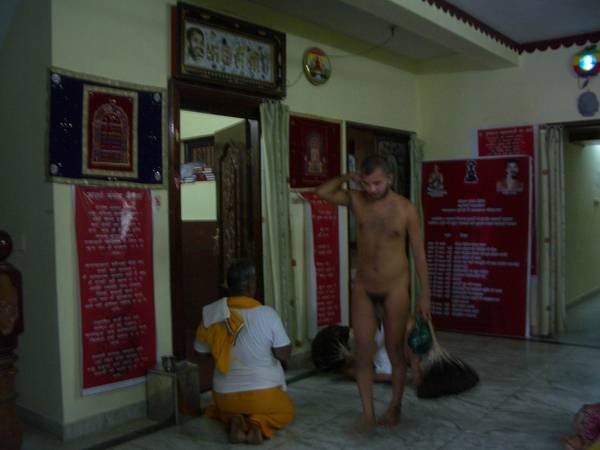
Digambara monk seeks alms
Image by Nalini Balbir © Nalini Balbir
Even though there is a longstanding association of nudity with advanced spirituality in wider Indian society, the public nudity of Digambara monks has been and sometimes still is an issue in public. A society led by non-Jain religions has often banned or discouraged public nudity at different periods.
Public nudity was not allowed in certain areas ruled by Muslims during late medieval times and made the circulation of Digambara monks problematic. Śrutasāgara, a 16th-century commentator, reports the case of a Digambara monk who allowed his group of monks to cover themselves with a mat or a piece of cloth when they went out seeking alms or for other purposes (quoted in Jaini 1991: 101). This, however, was felt to be an exceptional toleration of the sensitivities of another faith. Though it was intended to adapt practice to unexpected circumstances, covering any part of the body for Digambara monks was still considered wrong behaviour.
During British rule, this was again an issue (Scholz 2011: 260). It is said to partly explain the decline of Digambara monastic communities. The authorities ruled that Digambara monks had to wear clothes or keep some covering with them when they were in public, to put on if someone objected to their nakedness.
In the early 20th century, however, the tradition of monastic nudity was revived through three men who decided to initiate themselves (Wiley 2004: 159).
|
Name |
Details |
|---|---|
|
Ācārya Ādisāgara (1868–1943) |
|
|
Ācārya Śāntisāgara (1873–1955) |
(Wiley 2004: 192; Scholz 2011: 258–279) |
|
Ācārya Śāntisāgara (1888–1944) |
|
Since then Digambara monks have adopted the three stages of monkhood, progressing to full nudity. This process was customary before the Mughal period.
There is a law against public nudity in India, although nudity for religious purposes is customary among the mendicants of some Hindu sects as well as Digambara Jains. Nowadays occasional press reports show that the nudity of Digambara monks can be a source of conflict between the Jain community and non-Jains. This is particularly the case in areas where there are not many Digambara Jains and thus the general population is not used to the sight of naked Digambara monks, finding public nudity disturbing. The monks therefore may try to avoid public places in daytime. This happened, for instance, in 2008 in Puducherry.
In 2003 the late Digambara Jain activist Bal Patil made an official complaint to the Press Council of India about an article published on 2 March 2003 in the Sunday Times of India. Entitled ‘Privacy, Nudity & Jazz’, it included the following statement: ‘A certain sect of Jains – Digambars – who move about uncovered in public invoke their right to religious freedom’. No prosecution was made because the journalist’s argument that the sentence has to be read in context and was written in good faith was accepted. However, it was recognised that the feelings of a minority could have been hurt by this statement.
Such examples show that the nudity of Digambara monks can be a sensitive issue in today’s India as well as in the past, even though it is not a common sight given the small number of munis.
Reading
- ‘Naked Ascetics in Southern Digambar Jainism’
Michael Carrithers - Man (New Series)
volume 24: 2
Royal Anthropological Institute of Great Britain and Ireland; June 1989
- History of Jaina Monachism from Inscriptions and Literature
Shantaram Bhalchandra Deo - Deccan College Dissertation series; volume 17
Deccan College Postgraduate and Research Institute; Pune, Maharashtra, India; 1956
- The Jains
Paul Dundas - Library of Religious Beliefs and Practices series; series editor John Hinnels and Ninian Smart; volume 14
Routledge Curzon Press; London, UK; 2002
- Gender and Salvation: Jaina Debates on the Spiritual Liberation of Women
Padmanabh S. Jaini - University of California Press; Berkeley, California, USA; 1991
- The Digambara Jainas of South Maharashtra and North Karnataka Since the Late 19th Century: Towards the Establishment of a Collective Religious Identity and a Digambara Jaina Community
Sabine Scholz - PhD dissertation submitted to University of Manchester in 2011
- ‘The Revival of the Digambara Muni Tradition in Karnataka during the Twentieth Century’
Sabine Scholz - The Jaina Heritage: Distinction, Decline and Resilience
edited by Julia A. B. Hegewald
South Asian and Comparative Studies Heidelberg series; volume 2
Samskriti; New Delhi, India; 2011
- The Unknown Pilgrims: The voice of the sādhvīs – the history, spirituality, and life of the Jaina women ascetics
N. Shāntā - translated by Mary Rogers
Sri Garib Dass Oriental series; volume 219
Sri Satguru Publications; New Delhi, India; 1997
- Historical Dictionary of Jainism
Kristi L. Wiley - Historical Dictionaries of Religions, Philosophies, and Movements series; series editor Jon Woronoff; volume 53
Scarecrow Press; Maryland, USA; 2004
Links
- Terāpanthin monks and nuns
-
This YouTube video shows Śvetāmbara Terāpanthin monks and nuns walking down a street in New Delhi in July 2009. Clad in white and wearing the mouth cloth – muṃhpatti – they walk barefoot, carrying their monastic equipment in bags and bundles. They are accompanied by lay Jains, many of the women dressed in orange, which is a holy colour in India. Among the monks is Ācārya Mahāprajña, the tenth ācārya or leader of the sect, who died in May 2010.
- Five Great Monastic Vows
-
Pravin K. Shah writes about the Five Great Vows taken by Jain monks and nuns. The information is provided by the Jainism Literature Center, associated with the Faculty of Arts and Sciences at Harvard University.
http://www.fas.harvard.edu/~pluralsm/affiliates/jainism/jainedu/5greatvows.htm
- Group initiation of Digambara monks – part 1
-
After studying with him for four years, 25 men are initiated into Digambara monkhood by the monk Vidyāsāgar. At the start of the public renunciation ceremony – dīkṣā – the candidates resemble grooms, wearing jewels and turbans, their eyes outlined in kohl. They are then seen after the rite of keśa-loca. Dressed in orange and saffron robes, lay Jains dance in celebration. Scenes from the life of a Digambara monk are also shown, such as the monk carrying his broom and water pot, making the gesture to signal that he seeks alms. A group of fully nude monks leads the ailaka novices in loincloths, followed by the junior novices wearing white robes. Digambara nuns, wearing the white robe and holding the broom made of peacock feathers, are also shown in this YouTube video. This collective ceremony in Hindi took place on 21 August 2004 in the so-called Dayoday Tirth, Delwara Ghat, in the town of Jabalpur in Madhya Pradesh on the bank of the river Narmada. Watch the dīkṣā ceremony continue at: http://www.youtube.com/watch?v=zFfMGtC7zfI&NR=1
- Group initiation of Digambara monks – part 2
-
As part of their group ceremony of renunciation – dīkṣā – novice monks have the last tufts of hair plucked out by their teacher Vidyāsāgar. Then they remove their clothes amid the rejoicing of the large crowd of lay Jains. As a sign of detachment from worldly affairs, public nudity is associated with advanced spirituality and is the mark of a fully-fledged monk in Digambara Jainism. Then Vidyāsāgar traces the auspicious symbols of svastikas and four dots on their heads in sandalwood paste. Found on YouTube, this collective ceremony in Hindi took place on 21 August 2004 in the so-called Dayoday Tirth, Delwara Ghat, in the town of Jabalpur in Madhya Pradesh on the bank of the river Narmada. Watch the next part of the ceremony at: http://www.youtube.com/watch?v=K0WeUJici30&NR=1
- A Śvetāmbara nun descends from Shatrunjaya
-
A nun from a Śvetāmbara Mūrtipūjaka mendicant order runs barefoot down the steps leading down from Mount Shatrunjaya. This temple-city in Gujarat is one of the most significant Śvetāmbara Mūrtipūjaka pilgrimage sites. The steep path from the foot to the summit, where the principal shrines are found, has around 4000 steps.
- Digambara nuns pluck out their hair
-
In the keśa-loca rite, part of the renunciation ceremony of dīkṣā, new monks and nuns pull out their hair, which indicates indifference to worldly concerns, including pain. Ashes are smeared on the roots of the hair, making it easier to pluck out and reducing pain. In the Digambara sects, keśa-loca is a public ceremony. This rite took place among Digambara nuns, as shown by the peacock-feather broom – piñchī – one of them holds in this YouTube video. The dīkṣā was conferred by the nun Gaṇinī Āryikā Viśuddhamati mātājī in Kota, Rajasthan, a few years ago, though the precise date is unknown. The language used is Hindi, with Sanskrit and Prakrit for recitations from the scriptures.
- Procession to the renunciation ceremony
-
Dressed as a bride, the initiation candidate scatters money and gifts in a large public procession on her way to the renunciation ceremony to become a nun – dīkṣā. Nuns and lay women dressed in wedding saris walk behind her palanquin in this undated ceremony in Gujarat, found on YouTube.
- Śvetāmbara initation candidates in the crowd
-
As part of the renunciation ceremony to become a monk or nun – dīkṣā – the initiation candidates pass through a joyful crowd, who throw sandalwood powder over them. The initiates have already shaven and plucked out their hair and wear the white monastic robe of Śvetāmbara mendicants. This undated ceremony on YouTube takes place in Gujarat.
- +
- aAbhavya
- aAbhinandana
- aAbhiṣeka
- aĀcāra
- aĀcārāṅga-sūtra
- aĀcārya
- aAchalbhrata
- aAḍhāī-dvīpa
- aAdharma
- aAdho-loka
- aAdhyayana
- aAdvaita Vedānta
- aĀgama
- aAghātīya
- aAghātīya-karman
- aAgnibhuti
- aAgra
- aĀhāra
- aAhiṃsā
- aAhimsa Day
- aAjita
- aAjīva
- aAkampit
- aĀkāśa
- aAkbar the Great
- aAkṣaya-tṛtīyā
- aAlauddin Khalji
- aAlbert Einstein
- aAllah
- aAlms
- aĀlocanā
- aAloka-ākāśa
- aAmāri
- aAmbikā or Kūṣmāṇḍinī
- aAnagāra
- aAnanta
- aAnarthadaṇḍa
- aAnaśana
- aAnekānta-vāda
- aAṅga
- aAniconism
- aAnojjā
- aAntarāla
- aAntarāya-karma
- aAṇu
- aAṇu-vrata
- aAnukampā
- aAnuprekṣā
- aAnusvāra
- aApabhraṃśa
- aAparigraha
- aAra
- aĀrambha
- aĀrambhaja
- aĀratī
- aArdhamāgadhī Prākrit
- aArhaṃ
- aArhat
- aArśana-āvaraṇīya-karma
- aĀrta-dhyāna
- aĀryikā
- aĀryikā Jñānamati
- aĀśātanā
- aĀścarya
- aAscetic
- aAsceticism
- aAshram
- aAspiration
- aĀsrava
- aAṣṭa-maṅgala
- aAṣṭāpada
- aAstikāya
- aAstrolabe
- aAsura
- aAtheism
- aAticāra
- aAtiśayakṣetra
- aAtithisaṃvibhāgavrata
- aĀtma-vāda
- aĀtman
- aAuṃ
- aAurangzeb
- aAuspicious
- aAusterity
- aAvadhāna
- aAvadhi-jñāna
- aĀvaraṇī-yakarman
- aAvasarpiṇī
- aAvatāra
- aAvidyā
- aAxiom
- aĀyāga-paṭa
- aĀyambil
- aĀyu-karma
- aĀyurveda
- bBabur
- bBāhubali
- bBaladeva
- bBālāvabodha
- bBandha
- bBasadi
- bBazaar
- bBhadrankarvijay
- bBhagavant
- bBhaktāmara-stotra
- bBhakti
- bBhale
- bBharata
- bBhāṣā
- bBhāṣya
- bBhaṭṭāraka
- bBhāva
- bBhāva-pūjā
- bBhāvanā
- bBhavana-vāsin
- bBhavya
- bBhavyatva
- bBhaya
- bBhoga-bhūmi
- bBhogopabhoga
- bBodhi
- bBollywood
- bBrahmā
- bBrahma-deva
- bBrahmacārī
- bBrāhmaṇa
- bBraj Bhāṣā
- bBright fortnight
- bBritish Raj
- bBuddha
- bBuddhi-sagar
- bBuddhism
- bBuddhist
- cCaitya
- cCaityavāsin
- cCakravartin
- cCakreśvarī
- cCāmara
- cCandanā
- cCandragupta
- cCandraprabha
- cCanon
- cCāritra
- cCāritramohanīya-karman
- cCarũrī
- cCaste
- cCaturvidha-saṅgha
- cCaturviṃśati-stava
- cCāturyāma
- cCE
- cCelibacy
- cCha
- cChadmastha
- cChastity
- cCheda-sūtra
- cChristian
- cChristianity
- cClergy
- cCloning
- cColophon
- cCommentary
- cConch
- cConfession
- cCongregation
- cConsecration
- cCosmology
- cCremation
- cCrore
- cCult
- cCūrṇi
- dDādā-guru
- dDalit
- dDāna
- dDaṇḍa
- dDark fortnight
- dDarśana
- dDarśanamohanī-yakarman
- dDaśa-lakṣaṇa-parvan
- dDeity
- dDelhi Sultanate
- dDerāsar
- dDeśāvakāśika-vrata
- dDetachment
- dDevanāgarī
- dDevānandā
- dDevarddhi-gani
- dDevotee
- dDhamal
- dDhanuṣ
- dDhāra
- dDharma
- dDharma-dhyāna
- dDharma-sāgara
- dDharmastikaya
- dDhātakīkhaṇḍa
- dDholak
- dDhyāna
- dDiaspora
- dDig-vrata
- dDigambara
- dDīkṣā
- dDisciple
- dDīvālī
- dDivya-dhvani
- dDNA
- dDoctrine
- dDogma
- dDonor
- dDoṣa
- dDravya
- dDravya-pūjā
- dDrone
- dDuṣamā
- dDuṣamā-duṣamā
- dDuṣamā-suṣamā
- dDveṣa
- dDvīpa
- eEast India Company
- eEightfold Path
- eEkānta-vāda
- eEkendriya
- eElder
- eElders
- eEschatology
- eEtc up to
- fFarmān
- fFast
- fFatehpur Sikri
- fFestival
- fFestschrift
- fFiruz Shah
- fFly-Whisks
- fFolio
- fFour Noble Truths
- gGaccha
- gGaṇa
- gGaṇadhara
- gGanadharavada
- gGaṇeśa
- gGaṇin
- gGarba
- gGarbha
- gGarbha-gṛha
- gGaruḍa
- gGati
- gGene
- gGenomics
- gGhātī-yakarman
- gGhātīya
- gGhaznavid
- gGhiyasuddin Tughlaq
- gGhurid
- gGloss
- gGotra-karma
- gGujarāt
- gGujarati
- gGuṇa
- gGuṇa-sthāna
- gGuṇa-vrata
- gGupti
- gGuru
- gGuruṇī
- hHagiography
- hHajj
- hHaṃsa
- hHaribhadra
- hHariṇaigameṣin
- hHasta
- hHeresy
- hHiṃsā
- hHindi
- hHindu
- hHinduism
- hHīravijaya
- hHoroscope
- hHrīṃ
- hHumayun
- hHymn
- iIconoclasm
- iIconography
- iIdol
- iIndian Independence
- iIndology
- iIndra
- iIndrabhūti Gautama
- iIndriya
- iInitiation
- iIntercession
- iInvocation
- iIQ
- iIslam
- iIslamicate
- iIṣṭadevatā
- iĪśvara
- jJagat
- jJahangir
- jJain
- jJaina Devanāgarī
- jJaina Śaurasenī
- jJaina-dharma
- jJainaśāsana
- jJainness
- jJaisalmer
- jJamāli
- jJambū-dvīpa
- jJames Burgess
- jJanma
- jJanma-kalyāṇa
- jJarā
- jJāti
- jJina
- jJina-āgama
- jJina-bhavana
- jJina-bimba
- jJina-mātā
- jJinacandra-sūri
- jJinadatta
- jJinaprabha
- jJīva
- jJñāna
- jJñāna-āvaraṇīya-karma
- jJñāna-āvarṇiya
- jJñānsundar
- jJyotiṣka
- kKāla
- kKālakācārya-kathā
- kKālidāsa
- kKalpa-sūtra
- kKalpa-vṛkṣa
- kKalyāṇaka
- kKalyanvijay
- kKamaṇḍalu
- kKamaṭha
- kKarma
- kKarma-bhūmi
- kKarma-grantha
- kKarma-prakṛti
- kKarma-vāda
- kKarmon
- kKarnataka
- kKaṣāya
- kKathā
- kKāvya
- kKāya
- kKāyotsarga
- kKeśa-loca
- kKetu
- kKevala-jñāna
- kKevalin
- kKhalji
- kKharatara-gaccha
- kKnowledge
- kKriyā
- kKriyā-vāda
- kKṛṣṇa
- kKṣamā-śramaṇa
- kKṣapakaśreṇi
- kKṣatriya
- kKṣullaka
- kKulakara
- kKundakunda
- kKunthu
- lLabdhi
- lLaity
- lLakh
- lLāñchana
- lLands of Action
- lLaukāntika
- lLavaṇa-samudra
- lLeśyā
- lLiṅga
- lLinguistics
- lLoka
- lLoka-ākāśa
- lLoka-puruṣa
- lLoka-vāda
- lLotus
- lLotus lake
- mMadhya-loka
- mMahā-videha
- mMahā-vrata
- mMahābhārata
- mMahāmastakābhiṣeka
- mMāhārāṣṭra
- mMāhārāṣṭrī Prākrit
- mMahattarā Yākinī
- mMahāvīr Jayantī
- mMahāvīra
- mMakāra
- mMakkhali Gośāla
- mMalli
- mMāna-stambha
- mManaḥ-paryāya-jñāna
- mMaṇḍala
- mMaṇḍapa
- mMandit
- mMaṅgala
- mMantra
- mMantras
- mManuṣya-loka
- mMarāṭhī
- mMārgaṇā
- mMartyr
- mMarudevī
- mMaṭha
- mMati-jñāna
- mMauryaputra
- mMecca
- mMendicant lineage
- mMetarya
- mMiracle
- mMithyādṛṣṭi
- mMohandas Gandhi
- mMohanīya-karma
- mMokṣa
- mMonastic order
- mMonasticism
- mMonk
- mMonotheism
- mMosque
- mMount Meru
- mMount Sammeta
- mMṛgāvatī
- mMughal
- mMuhammad
- mMuhammad bin Tughlaq
- mMuhpattī
- mMūla-sūtra
- mMūlaguṇa
- mMumbaī
- mMuni
- mMunisuvrata
- mMurad Bakhsh
- mMūrti-pūjaka
- mMuslim
- mMysticism
- nNābhi
- nNāga-kal
- nNāgapurīya Tapā-gaccha
- nNāgarī
- nNāma-karma
- nNamaskāra-mantra
- nNami
- nNandīśvara-dvīpa
- nNandivardhana
- nNandyāvarta
- nNāraka
- nNāraki
- nNasalisation
- nNātha
- nNavrātrī
- nNaya-vāda
- nNemi
- nNidāna
- nniggaṃthāṇa vā 2
- nniggaṃtho vā 2
- nNigoda
- nNihnava
- nNikṣepa
- nNirgrantha
- nNirjarā
- nNirvāṇa
- nNiryukti
- nNiṣidhi
- nNitya
- nNiyati
- nNo-kaṣāya
- nNudity
- nNun
- oOcean of milk
- oOmniscience
- oOrdination
- ppa°
- pPadmaprabha
- pPadmāsana
- pPadmāvatī
- pPādukā
- pPalanquin
- pPalette
- pPañca-muṣṭi
- pPāṇḍava
- pPaṇḍit
- pPandit Dalsukh D. Malvania
- pPandit Sukhlalji
- pPāṇipātra
- pPāpa
- pParamātman
- pParameṣṭhin
- pPāraṇā
- pParigraha
- pPariṇāma
- pParīṣaha
- pParokṣa
- pPārśva
- pPārśvanātha
- pParyāya
- pParyuṣaṇ
- pPaṭa
- pPatan
- pPātra
- pPenance
- pPersian
- pPhala
- pPhilology
- pPicchikā
- pPilgrimage
- pPīr
- pPolymath
- pPoṣadha
- pPossession
- pPothī
- pPrabhas
- pPradakṣiṇā
- pPradeśa
- pPrākāra
- pPrakīrṇaka-sūtra
- pPrākrit
- pPramāda
- pPramukhā
- pPrati-vāsudeva
- pPratikramaṇa
- pPratimā
- pPratiṣṭhā
- pPratyākhyāna
- pPratyakṣa
- pPravacana
- pPrāyaścitta
- pPrayer
- pPre-modern
- pPreach
- pPredestination
- pProtestant
- pProvenance
- pPudgala
- pPūjā
- pPujārī
- pPukharavara-dvīpa
- pPuṇya
- pPūrva
- pPuṣkara-dvīpa
- pPuṣpadanta
- pPyre
- qQur’an
- rRāga
- rRāhu
- rRainy season
- rRajasthan
- rRajasthani
- rRājimatī
- rRajoharaṇa
- rRajput
- rRāma
- rRāmāyaṇa
- rRangoli
- rRās-garbā
- rRasa
- rRathanemi
- rRatna-traya
- rRātri-bhojana
- rRaudra-dhyāna
- rRecto
- rRelic
- rRenunciation
- rRetroflex
- rRevatī
- %Ṛg-veda
- rRite
- rRosary
- %Ṛṣabha
- %Ṛṣabhanātha
- rRupee
- sSaciyā Mātā
- sSādhu
- sSādhvī
- sSāgāra
- sSaint
- sŚaivaism
- sŚaka-saṃvat
- sSallekhanā
- sŚalya
- sSamacatuṣṭha
- sSamādhimaraṇa
- sSamaṇi
- sSāmarambha
- sSamavasaraṇa
- sSāmāyika
- sSaṃbhava
- sSamiti
- sSaṃjñā
- sSaṃkalpaja
- sSaṃsāra
- sSamudghāta
- sSaṃvara
- sSaṃvega
- sSamyak-cāritra
- sSamyak-darśana
- sSamyak-jñāna
- sSamyaktva
- sSaṃyama
- sSanctuary
- sSandalwood
- sSaṇgha
- sSanskrit
- sSant
- sŚānti
- sSapta-bhaṅgi-naya
- sSārambha
- sSarasvatī
- sSarvajña
- sSāsan-devi
- sŚāsana-devatā
- sŚāstra
- %Ṣaṭ-jīvanikāya
- sSatī
- sSatīmātā
- sSatya
- sSchism
- sScribe
- sScripture
- sSect
- sSecularism
- sŚenāī
- sSermon
- sŚeṣavatī
- sSevā
- sSeven fields of donation
- sShah Jahan
- sShantidas Jhaveri
- sShrine
- sSiddha
- sSiddha-śilā
- sSiddhacakra or Navadevatā
- sSiddhānta
- sSiddhārtha
- sSiddhi
- sSikh
- sSikhism
- sŚikṣā-vrata
- sŚīla
- sSin
- sSindh
- sŚītala
- sŚiva
- sSkandha
- sSomanatha
- sŚraddhā
- sŚramaṇa
- sŚrāvaka
- sŚrāvakācāra
- sŚrāvikā
- sŚreyāṃsa
- sŚrī
- sŚrīvatsa
- sŚruta-jñāna
- sŚruta-pañcamī
- sSthānaka-vāsin
- sSthāpanācārya
- sSthāvara
- sSthavira
- sSthiti
- sStrīmukti
- sStūpa
- sSubcontinent
- sSudarshana
- sŚuddhi
- sSudharma
- sŚūdra
- sSufism
- sSukha
- sŚukla-dhyāna
- sSulasā
- sSultan
- sSumati
- sSundarśrī
- sSupārśva
- sSūri
- sSuṣamā
- sSuṣamā-duṣamā
- sSuṣamā-suṣamā
- sSūtra
- sSuyam me ausam! Tenam bhagavaya evamakkhayam
- sSvādhyāya
- sSvāhā
- sSvastika
- sŚvetāmbara
- sŚvetāmbara Terāpanthin
- sŚvetāmbaras
- sSwan
- sSyād-vāda
- tTabla
- tTantra
- tTapā-gaccha
- tTapas
- tTāraṇ Svāmī Panth
- tTattva
- tTattvārtha-sūtra
- tTemple
- tTemple-city
- tThe Enlightenment
- tTheology
- tThree worlds
- %Ṭīkā
- tTilaka
- tTīrtha
- tTīrthaṃkaranāma-karman
- tTīrthankara
- tTransliteration
- tTrasa
- tTrasa-nāḍī
- tTriśalā
- tTriṣaṣṭi-śalākā-puruṣa-caritra
- tTti bemi
- tTughlaq
- tTunk
- uUdumbara
- uUniversal History
- uUpādhyāya
- uUpāṅga
- uUpaniṣads
- uUpāsaka
- uUpasarga
- uUpāśraya
- uŪrdhva-loka
- uUtsarpiṇī
- uUttarādhyayana-sūtra
- vVāhana
- vVaimānika
- vVairāgya
- vVaiṣṇava
- vVaiśramaṇa
- vVaiśya
- vValabhī
- vVanaspatikāya
- vVandana
- vVaṇik
- vVarṇa
- vVāsudeva
- vVāsupūjya
- vVayubhūti
- vVeda
- vVedanīya-karma
- vVegetarianism
- vVehicle
- vVernacular
- vVerso
- vVidyā
- vVidyā-devī
- vVihāra
- vVijñapti-patra
- vVikrama-saṃvat
- vVikṛti
- vVimala
- vVinaya
- vVipāka
- vVirji Vora
- vVirodhaja
- vVīrya
- vVisarga
- vViṣṇu
- vVītarāga
- vVizier
- vVotive
- vVow
- vVrata
- vVS
- vVyakta
- vVyantara
- vVyasana
- yYakṣa
- yYakṣī
- yYantra
- yYaśoda
- yYaśovijaya
- yYati
- yYātrā
- yYoga
- yYoginī
- yYojana


